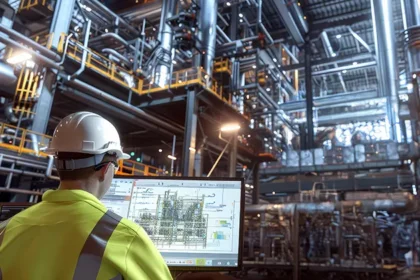Every modern facility fights the same battle between efficiency and control. You need motors running at full power, but you also need to optimize that power based on actual demand. Running everything at maximum all the time wastes energy and creates unnecessary wear. Finding that balance between full capability and efficient operation is where most systems struggle. The equipment either runs hot or runs inefficiently, rarely finding that sweet spot between the two extremes.
ABB drives give engineers finer command of motors while cutting waste simultaneously. Instead of motors running at fixed speeds regardless of actual need, drives adjust voltage and frequency in real-time based on what’s actually required. That means heavy lifting happens when needed, but routine operations happen at reduced power consumption. The ability to modulate motor performance creates opportunities for efficiency that fixed-speed motors simply can’t achieve.
Understanding how ABB drives work reveals why engineers across industries consider them essential infrastructure. These systems quietly power entire facility operations while saving substantial energy costs. The technology seems simple on the surface, but the engineering underneath solves real operational challenges that facilities face constantly. That’s what makes ABB drives so respected in industrial environments.
The Science of Variable Speed Control
How drives optimize current and voltage represents the core engineering that makes everything work. Traditional motors consume power at a relatively constant rate regardless of load. Drives measure actual load requirements and adjust electrical input to match those requirements precisely. When demand is light, drives reduce both current and voltage, cutting power consumption dramatically. When demand peaks, drives increase electrical input to provide full power instantly. That dynamic adjustment happens automatically and continuously, responding to changing conditions in real-time.
Energy savings in motion-heavy systems become substantial when you understand the volume of time motors operate at partial load. Most facilities run motors at full capacity maybe thirty percent of the time. The other seventy percent involves partial load or idle periods where full power goes wasted. Drives capture that wasted power potential by reducing consumption during low-demand periods. Over months and years, those reductions compound into significant cost savings that justify drive installation and maintenance investment.
The efficiency gains extend beyond just energy consumption. Reduced electrical stress means motors last longer because they’re not constantly operating at maximum specifications. Reduced heat generation means cooling systems work less, creating secondary energy savings. Reduced mechanical stress means bearings and components experience less wear. That cascade of efficiency improvements means systems remain reliable longer and require less maintenance. The investment in drives pays returns through extended equipment life alongside direct energy savings.
Real Applications Across Industries
HVAC systems benefit enormously from drives because heating and cooling demand varies constantly throughout the day. Summer cooling requirements peak during afternoon heat and drop at night. Winter heating requirements peak during morning cold and evening. Instead of compressors running constantly at full capacity, drives let them modulate based on actual temperature requirements. That modulation cuts HVAC energy consumption significantly because the system uses exactly what’s needed instead of constant maximum operation.
Manufacturing facilities use drives extensively because production demands fluctuate based on order volumes and production schedules. Equipment might run at full capacity during peak production then drop to minimal operation during low-demand periods. Drives enable equipment to operate efficiently across that entire range of demand without wasting energy during low-production phases. The ability to modulate production speed without losing capability creates manufacturing flexibility that fixed-speed equipment can’t match.
Oil and gas operations depend on drives for pump systems that move fluid across vast distances and elevations. Pipeline systems require consistent pressure and flow, but actual demand varies based on upstream supply and downstream consumption. Drives maintain optimal pressure and flow conditions dynamically, preventing waste and ensuring system reliability. Logistics facilities use drives extensively for conveyor systems and material handling equipment where speed requirements change based on throughput. That adaptability across different applications demonstrates why drives are foundational industrial infrastructure.
What Makes ABB Different
Reliability represents the primary reason engineers specify ABB drives across such diverse applications. These systems operate continuously in challenging industrial environments without frequent failures. That reliability comes from conservative engineering that prioritizes performance over theoretical optimization. ABB designs drives to handle real-world conditions including voltage fluctuations, temperature extremes, and mechanical stresses that theoretical specifications don’t always account for. That practical engineering approach means systems work reliably in actual facilities rather than just on paper.
Modular design allows customization without requiring complete system replacement when needs change. Add monitoring capabilities, add communication protocols, add specific control algorithms, all without replacing the core drive hardware. That modularity means drives scale with facilities and evolve as requirements change. Systems that can adapt prove more valuable than systems that lock you into specific configurations. The ability to upgrade and reconfigure drives as technology advances keeps systems current and capable without massive capital investment.
Smart monitoring capabilities embedded in modern ABB drives provide real-time data about system performance and health. Predictive analytics identify potential failures before they happen, allowing preventive maintenance instead of reactive repairs. That monitoring also reveals efficiency opportunities and operational inefficiencies that might otherwise go unnoticed. Access to that data transforms drives from passive equipment into active intelligence sources that inform maintenance and operational decisions.
Future Trends in Automation
Predictive maintenance evolves from reactive repairs to proactive system management. Drives equipped with advanced sensors and analytics predict bearing wear, thermal stress, and efficiency degradation before failures occur. That predictive capability lets facilities schedule maintenance during planned downtime instead of suffering emergency failures. The cost savings from prevented downtime far exceed maintenance costs, making predictive capabilities increasingly valuable as industrial operations become more complex and downtime becomes more expensive.
IoT integration connects drives to broader facility management systems, creating comprehensive operational visibility. Drives become part of integrated ecosystems where they communicate equipment status, energy consumption, and performance metrics to central management platforms. That integration enables optimization at the facility level rather than individual equipment level. Systems can coordinate across multiple drives and equipment to maximize overall efficiency and performance. That holistic approach represents the evolution of industrial automation toward intelligent, integrated systems.
Edge computing capabilities embedded in drives enable local decision-making without constant communication to central systems. Drives can respond instantly to changing conditions based on local algorithms rather than waiting for commands from central systems. That distributed intelligence combines with central coordination to create systems that are both responsive and optimized. As industrial automation becomes more sophisticated, that balance between local responsiveness and central optimization becomes increasingly important for system reliability and efficiency.
Conclusion
ABB drives are redefining industrial efficiency with smart control technology that optimizes motor performance while reducing energy consumption. Engineers across industries recognize drives as essential infrastructure because they solve real operational challenges that fixed-speed motors simply can’t address. The reliability, modularity, and monitoring capabilities make drives valuable investments that pay returns through efficiency savings, extended equipment life, and reduced maintenance costs.
The technology enables facilities to do more with less by optimizing how and when equipment operates. That optimization happens automatically and continuously, requiring minimal human intervention beyond initial programming. Systems that adapt and optimize with changing conditions prove more valuable than static systems locked into fixed operational parameters.
Modern facilities that ignore drive technology are leaving substantial efficiency gains and cost savings on the table. ABB drives represent proven technology that delivers measurable returns across diverse industrial applications. As automation evolves and efficiency becomes increasingly critical, drive technology becomes more valuable, not less. The future of industrial operations depends on systems that think, adapt, and optimize continuously. That’s what ABB drives deliver.










